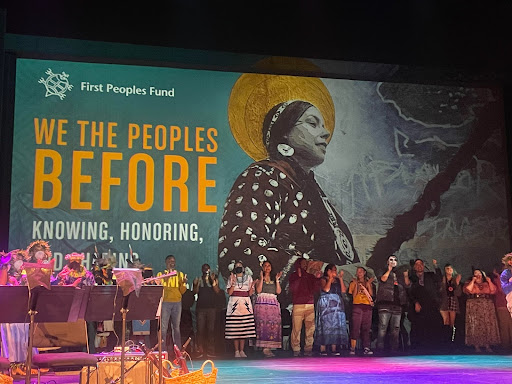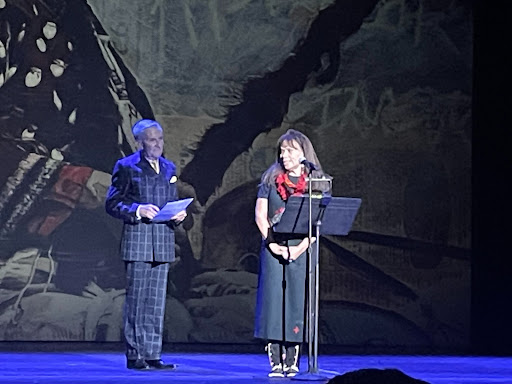
- Details
- By Levi Rickert
WASHINGTON, D.C. — The Kennedy Center’s Eisenhower Theater was sold out on Friday, July 1st for the We The Peoples Before stage production that drew a crowd of Native Americans from various parts of Indian Country as well as other attendees who sat for the two-hour long performance.
The First Peoples Fund, an organization that supports the collective spirit of Native Americans artists, hosted the event that brought more than 50 Native performers to the stage, including Joy Harjo (Muscogee Creek Nation), Supaman (Apsaalooke Nation), and Pura Fe Crescioni (Tuscarora/Taino).
 Joy Harjo (Muscogee Creek Nation)
Joy Harjo (Muscogee Creek Nation)
Friday night’s performance was part of a three-day festival that coincided with the 25th anniversary of the First Peoples Fund and the 50th anniversary of the John F. Kennedy Center.
“This location feels like the stars have aligned and here we are tonight. We are here to tell our story, as it should be told through our legs, from our hearts and from the place of resilience and love, the love for ancestral homelands and territories,” Lori Pouiri (Oglala Sioux Tribe), president of the First Peoples Fund, said during her opening remarks.
We The Peoples Before was billed as a collaboration in recognition of the rightful place of Native cultural practice as a central influence on the national landscape of arts and culture in the United States.
 A portion of the production’s cast.
A portion of the production’s cast.
The production was a spectacular performance of Native American talent that mixed narrative, song, and dance. The performance told historic stories of purposeful attempts to destroy Native peoples by genocide and the intention of stripping the Indigenous people of this continent of their land and culture.
National Center for American Indian Enterprise Development board member Ron Solimon (Laguna Pueblo) traveled with his wife from Albuquerque, New Mexico, for the festival.
“Last night’s performance was just simply sensational,” Solimon told Native News Online. “The performance left me feeling bubbly. The diversity of culture, all the singing, and the other kinds of talent that was expressed there was fabulous.”
 Richard West, Jr. (Cheyenne and Arapaho Tribes) and Lori Pouiri (Oglala Sioux Tribe)
Richard West, Jr. (Cheyenne and Arapaho Tribes) and Lori Pouiri (Oglala Sioux Tribe)
Shannon Martin (Gun Lake Tribe), accompanied her elderly parents to the Kennedy Center from Michigan. Martin, a consultant who is the former director of the Ziibiwing Center of Anishinabe Culture and Lifeways in Mt. Pleasant, Mich., said the production invoked the resiliency of our people by revisiting where we come from and understanding the hardship and the adversity we have lived through.
“The eclectic body of work highlighted both our traditional storytelling lifeways to the contemporary, dynamic storytelling of our youth through slam poetry and hip hop lyrics.
For me, the feeling of sitting in the middle of the room, the Eisenhower Theater at the Kennedy Center, surrounded by black and brown people, was just amazing,” Martin said.
Martin says she would like to see the National Endowment for the Arts fully fund the production to take it on the road and tour North America and the world because of the message and the history and the celebration of who we are as Indigenous people should be shared.
More Stories Like This
A Native American Heritage Month Playlist You Can Listen to All Year Long11 Native Actors You Should Know
Five Native American Films You Should Watch This Thanksgiving Weekend
Heavy metal is healing teens on the Blackfeet Nation
Over 150 Tribal Museums Participate in Fourth Annual Celebration of Native Life
Help us tell the stories that could save Native languages and food traditions
At a critical moment for Indian Country, Native News Online is embarking on our most ambitious reporting project yet: "Cultivating Culture," a three-year investigation into two forces shaping Native community survival—food sovereignty and language revitalization.
The devastating impact of COVID-19 accelerated the loss of Native elders and with them, irreplaceable cultural knowledge. Yet across tribal communities, innovative leaders are fighting back, reclaiming traditional food systems and breathing new life into Native languages. These aren't just cultural preservation efforts—they're powerful pathways to community health, healing, and resilience.
Our dedicated reporting team will spend three years documenting these stories through on-the-ground reporting in 18 tribal communities, producing over 200 in-depth stories, 18 podcast episodes, and multimedia content that amplifies Indigenous voices. We'll show policymakers, funders, and allies how cultural restoration directly impacts physical and mental wellness while celebrating successful models of sovereignty and self-determination.
This isn't corporate media parachuting into Indian Country for a quick story. This is sustained, relationship-based journalism by Native reporters who understand these communities. It's "Warrior Journalism"—fearless reporting that serves the 5.5 million readers who depend on us for news that mainstream media often ignores.
We need your help right now. While we've secured partial funding, we're still $450,000 short of our three-year budget. Our immediate goal is $25,000 this month to keep this critical work moving forward—funding reporter salaries, travel to remote communities, photography, and the deep reporting these stories deserve.
Every dollar directly supports Indigenous journalists telling Indigenous stories. Whether it's $5 or $50, your contribution ensures these vital narratives of resilience, innovation, and hope don't disappear into silence.
 The stakes couldn't be higher. Native languages are being lost at an alarming rate. Food insecurity plagues many tribal communities. But solutions are emerging, and these stories need to be told.
The stakes couldn't be higher. Native languages are being lost at an alarming rate. Food insecurity plagues many tribal communities. But solutions are emerging, and these stories need to be told.
Support independent Native journalism. Fund the stories that matter.
Levi Rickert (Potawatomi), Editor & Publisher

